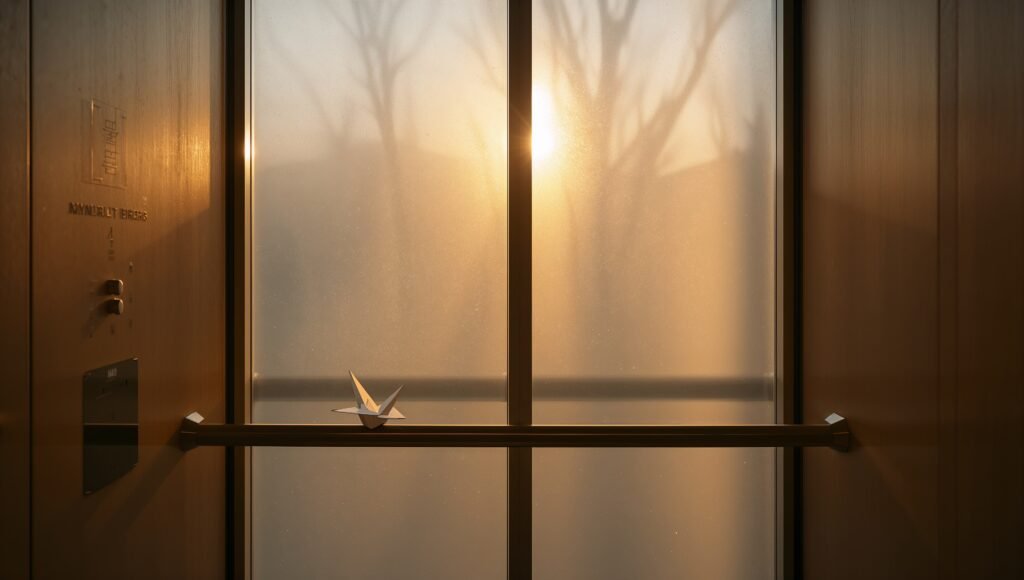
Elevator Etiquette: The Unspoken Rules of Silence
The scent of metal mingles with artificial light. Even the sound of human breath wants to hide. The moment elevator doors close, something happens—an invisible shift in elevator etiquette takes hold. Maybe gravity shifts. Maybe time stops. Or maybe some switch inside humans turns off, activating the unspoken rules of confined space behavior.
People trapped within four walls suddenly forget they belong to the same species. A miraculous transformation occurs through this strange social anxiety ritual. They become perfect strangers, bound by elevator etiquette’s silent commandments. Someone coughs and others flinch. As if a forbidden sound violated the sacred code.
The red floor number glows and dims. Like a heartbeat. But the heartbeats of people inside this box merge into one awkward silence symphony. Their eyes avoid each other, following elevator etiquette’s most fundamental rule. Like opposite poles of magnets. Everyone’s gaze rises upward. Someone’s shoelace comes undone. They bend down to tie it. Others don’t look—respecting the invisible boundaries of confined space behavior.
Inside this gleaming steel coffin, each person becomes an island. No bridge exists between them, as elevator etiquette demands. Someone’s phone vibrates. They quickly silence it. As if a crime occurred against the unwritten social contract. The person staring at their phone screen isn’t really reading anything. Just trying to convince themselves they’re busy—a classic elevator etiquette defense mechanism.
The act of searching inside a bag for something becomes like a magic trick. A woman searches the same pocket three times. Finds nothing. Searches again. This pretense of searching becomes shelter from social anxiety. A safe place. Where you can hide for a few seconds, protected by elevator etiquette’s understanding that looking busy is acceptable. Fingers touch keys, pens, tissues. Familiar things. But in this moment they feel foreign, new.
Eyes staring at walls seem to read some invisible book—the unwritten manual of elevator etiquette. A young man presses his floor button again. Knows it’s already lit. Still presses. Maybe there’s a story written there about how to be perfectly unknown, how to master the art of confined space behavior.
The elevator motor hums and mixes with everyone’s breathing, creating the soundtrack to this awkward silence. Steel cables whisper overhead like secrets being shared. A strange symphony forms—the music of elevator etiquette in action. The floor vibrates almost imperceptibly under their feet. Just a monotonous, heavy, muffled sound that reminds you time moves forward, life moves forward, but everything inside this box remains frozen by social anxiety’s grip.
Third floor—doors open. Someone escapes like being freed from the pressure of elevator etiquette. The rest stare at the doorway—like a ray of light, a taste of freedom from confined space behavior. But when doors close again, the same atmosphere returns. Now they’re fewer in number, but the distance grows greater, the awkward silence deeper.
Air gets trapped here in this vertical prison of elevator etiquette. When someone exhales, that air can’t escape. Someone’s stomach growls. They quickly press their hand against it. Others pretend not to hear—following the sacred rules. The warmth of bodies creates a subtle heat that clings to skin. Someone’s coffee breath mingles with another’s faint perfume. The same air repeatedly enters lungs, exits, enters again, shared yet separate.
The mirror shows distorted reflections of people practicing elevator etiquette. Everyone’s face looks different. Someone quietly fixes their hair. Others pretend not to see—respecting the illusion of privacy in this public space. Sometimes eyes meet in this mirror. Immediately they look away. As if a serious violation of confined space behavior occurred.
Going up creates pressure in ears. Not just air pressure, but the pressure of social anxiety and awkward silence too. This pressure makes you think something might burst, some dam might break. But nothing happens. Elevator etiquette holds firm. Everything stays as it was.
Sixth floor, seventh floor, eighth floor—numbers change, but the confined space behavior remains the same. Each floor holds a possibility—maybe someone new will enter, maybe someone will leave. But new people mean new silence, new distance, new unfamiliar faces to navigate with elevator etiquette’s complex rules.
The moment before reaching the final floor feels strangest. Everyone knows this journey is ending, this social anxiety experiment is ending. Yet it feels like something remains incomplete. No words were spoken, no eye contact made, no connection formed despite sharing this intimate space. Just a few minutes together, but in separate worlds, bound by the invisible chains of elevator etiquette.
Doors open. One by one, everyone exits from this masterclass in awkward silence. No one looks back. Those who were companions in confined space behavior for these few minutes become strangers again. As if they were never together, never breathed the same air, never drowned in the same silence. This small box empties again, waiting for other people to practice the ancient art of elevator etiquette. And the people move toward their destinations, carrying memories of that silence, that feeling of distance, that perfect execution of unspoken social rules.
Share Your Reflection
Your insights enrich our collective understanding. What thoughts does this spark in your mind?